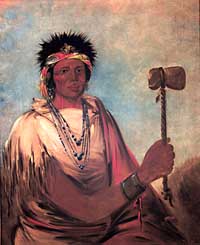
 |
Ground Stone
Men-son-se-ah, a Piankashaw man holding a hatchet with a ground-stone head. (watercolor by George Catlin, 1830) |
[T]he Calumet [pipe bowl] . . . is fashioned from a red stone, polished like marble, and bored in such a manner that one end serves as a receptacle for the tobacco, while the other fits into the stem; this is a stick two feet long, as thick as an ordinary cane, and bored through the middle. (Jacques Marquette, 1674)![]()
Ground-stone tools were made from pieces of limestone, sandstone, and granitic cobbles, which were available locally in rock outcrops and deposits of stone left behind by glaciers. Granitic cobbles were pecked and ground to create elongate celts, which were attached to handles and used as hatchets or clubs. Manos, also made from cobbles, were used in conjunction with slab-shaped stones called metates to grind corn into meal. Unmodified cobbles were used as hammerstones for making chipped-stone tools. Pieces of coarse sandstone were often grooved on one or more surfaces. The grooves were used as abraders for smoothing arrow shafts or for sharpening other tools made of bone or shell.
The Illinois also used Catlinite, a red pipestone composed of hardened clay, which was imported from a quarry located in southern Minnesota. Catlinite was carved to make the special pipe bowls that were attached to the wooden stems of calumets. Smaller pieces of Catlinite were carved into triangular pendants, which were suspended from necklaces or attached to clothing as decorative ornaments.![]()
|
|
Copyright © 2000 Illinois State Museum